When you think of Niagara Falls, especially the tourist areas like Cliffton Hill and Lundy’s Lane one of the last things you think is a historic battleground. Today there’s an arch over Lundy’s Lane announcing what it is, but for the most part, it’s places like Fort George, Fort Erie, and Queenston Heights that get all the glory. But in 1814 a bloody battle at the cemetery on Lundy’s Lane changed the course of the American 1814 summer offensive. It was the turning point of the whole matter, and it didn’t go too well for the Americans after that.
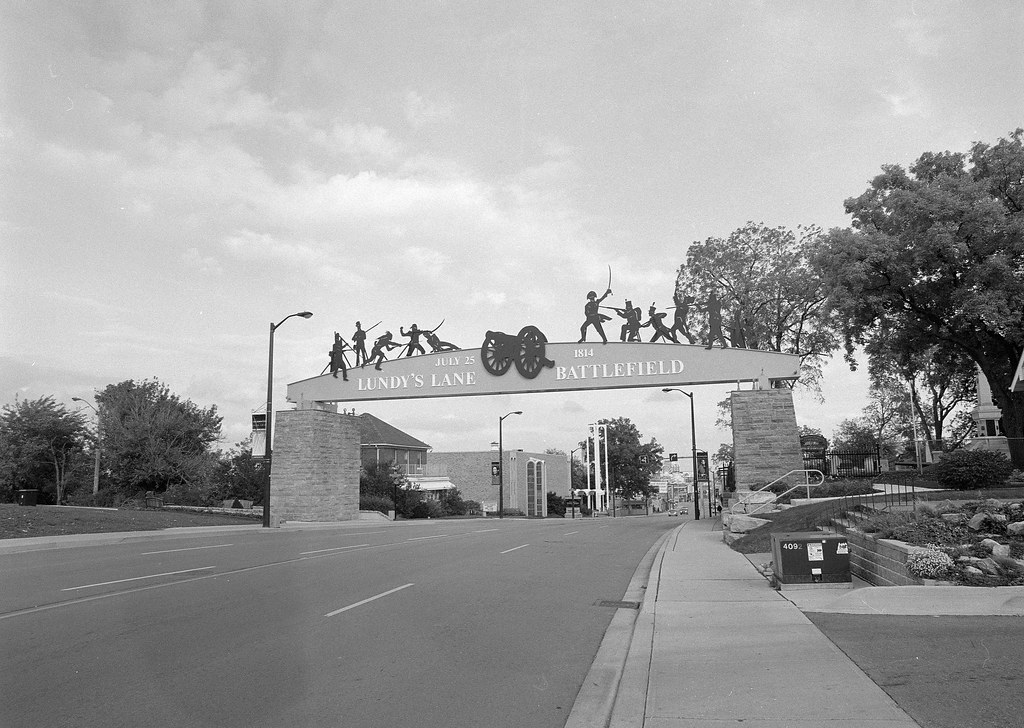
A memorial arch across Lundy’s Lane as drivers approach the battlefield.
Pentax 645 – SMC Pentax A 645 35mm 1:3.5 – Kodak Tri-X 400 – Kodak Xtol (1+1) 9:00 @ 20C
On the 3rd of July, 1814 a large American army raised and trained by two brilliant American Commanders, Winfield Scott, and Jacob Brown had crossed the Niagara River and in quick order forced the surrender of the British garrison at Fort Erie and proceeded to roll up the peninsula. Scoring a victory at Chippawa and forcing the British to retreat to Fort George at Niagara-On-The-Lake. The Americans continued their advance and once again occupy Queenston. General Jacob Brown desired to catch the British between two armies and waited for Commodore Isaac Chauncy to land a second force on the opposite side of the British garrison. A force that would not land, the bed-ridden Chauncy refused to allow another man to command his precious squadron and degrade it again to be used as troop transports. The American occupation for a third time wore on the civilian population, and they began to turn against the occupation force. The American commanders did not take this resistance well and had the small village of St. Davids burned in retaliation. An act abhorred by General Brown who dismissed the general who ordered the action. But the lack of reinforcements forced Brown to pull back to Chippawa; this gave the British a chance to set up a forward post at the cemetery on Lundy’s Lane just up the hill from the mighty Niagara Falls.
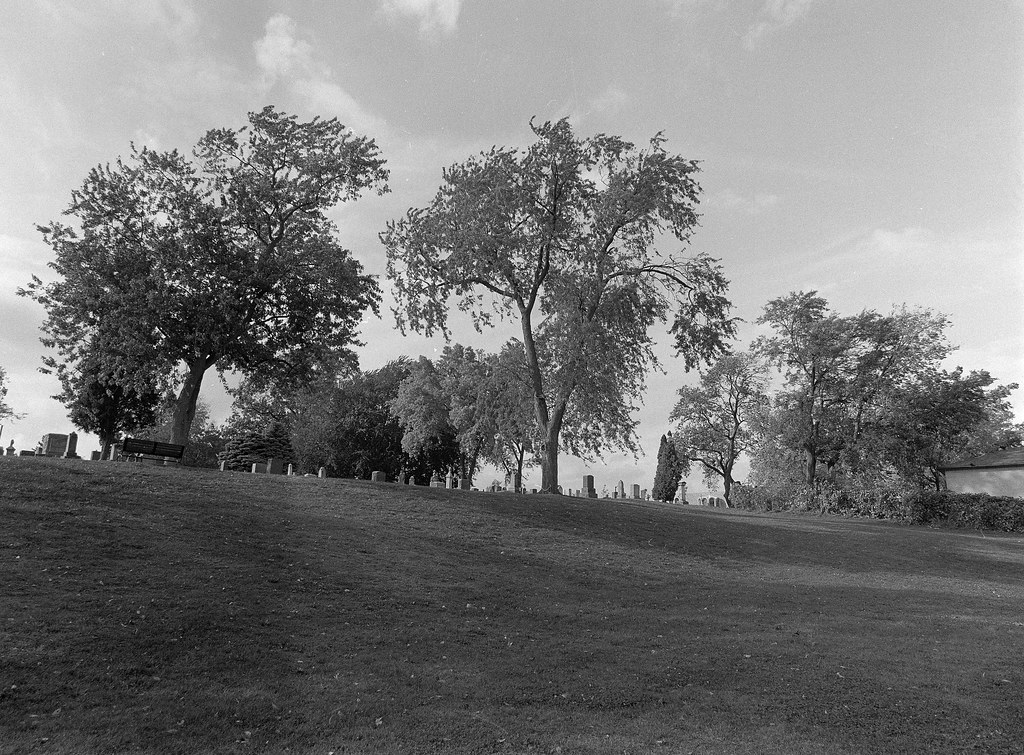
Looking up the hill where the British Battery stood. Standing there only highlights the difficulty of the action.
Pentax 645 – SMC Pentax A 645 35mm 1:3.5 – Kodak Tri-X 400 – Kodak Xtol (1+1) 9:00 @ 20C
Word reached Brown from his forward posts that the British were moving forward and fearing for a swift British action that would see his reduced army defeated Brown decided to take the fight to the British. Winfield Scott’s division marched for Lundy’s Lane having performed well against the British at Chippawa. Scott had one more advantage against the British; he knew that he could easily force Riall to run if his men showed the same discipline as they had at Chippawa. Despite leading his men against a well-defended force on the high ground, he marched anyways. It worked exactly has he had planned, upon the sight of the American troops Riall ordered a full retreat to Queenston. But Scott had failed to account for the arrival of General Gordon Drummond, the firey Lieutenant-Governor of Upper Canada with fresh reinforcements for the besieged peninsula.
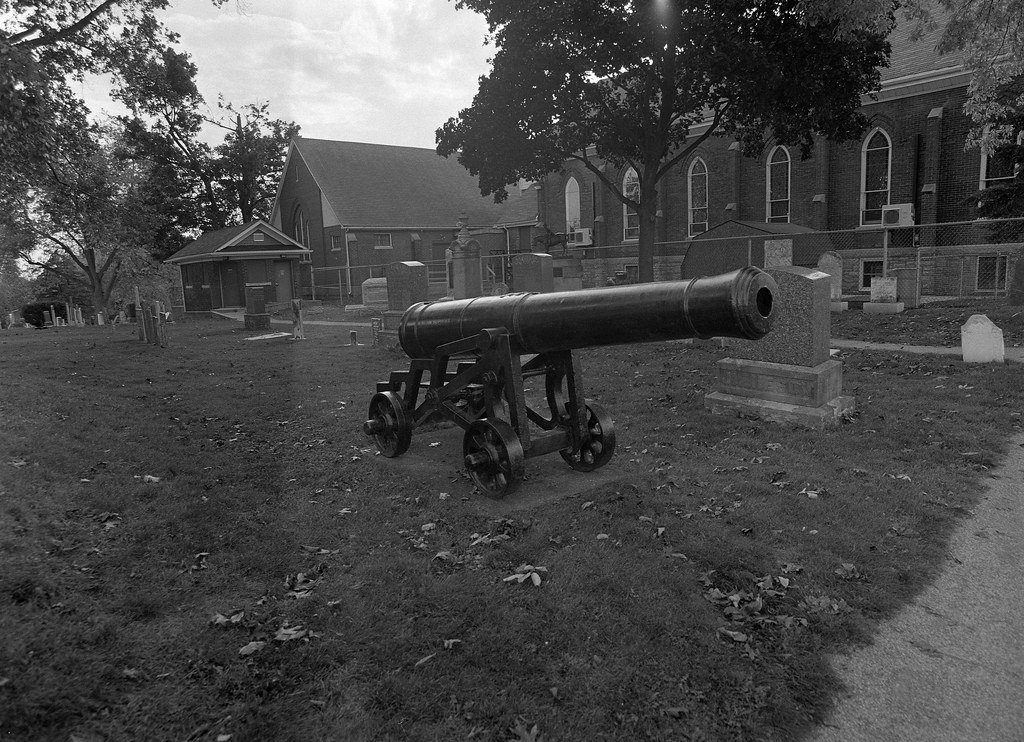
A former British artillery piece now on display next to the battle monument.
Pentax 645 – SMC Pentax A 645 35mm 1:3.5 – Kodak Tri-X 400 – Kodak Xtol (1+1) 9:00 @ 20C
Drummond’s first action was reversing Riall’s retreat order bringing the British back and opening up the action against Scott’s division. Scott had hoped to use the 25th US Infantry to outflank and force Drummond’s retreat, but their attempt forced them into a pitched battle with the 8th (King’s) and the Incorporated Militia of Upper Canada. With daylight fading the quick action was not going well. General Brown arrived with his division to reinforce the nearly beaten men of Scott’s division. Brown was in luck, Scott’s efforts had not been in vain, and exposed the British artillery crews, the 21st US Infantry surged forward and in a single volley scattered the Royal Artillery Crews. The Americans had taken the hill.
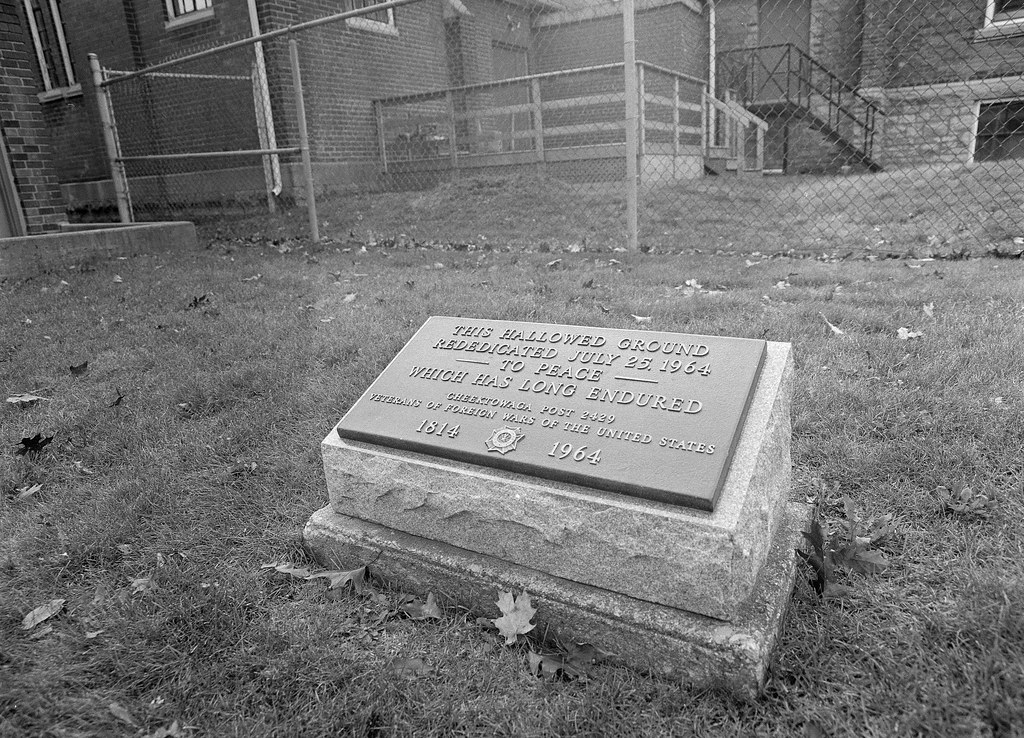
A memorial to the American soldiers who died in the carnage of the battle.
Pentax 645 – SMC Pentax A 645 35mm 1:3.5 – Kodak Tri-X 400 – Kodak Xtol (1+1) 9:00 @ 20C
The American advance was short lived, Drummond rallied the troops and charged in with bayonets fixed, as the fight changed from disciplined volleys to hand-to-hand carnage. And in the fading light, only chaos reigned in the fight. General Riall would find himself captured by American troops believing he was among friends. The 103rd Regiment fired a shattering volley into a group of soldiers from the Glengarry Light Infantry believing them to be a force of American riflemen lurking in the woods. By midnight only the cries of wounded and dying could be heard, both armies retreated in disorder.
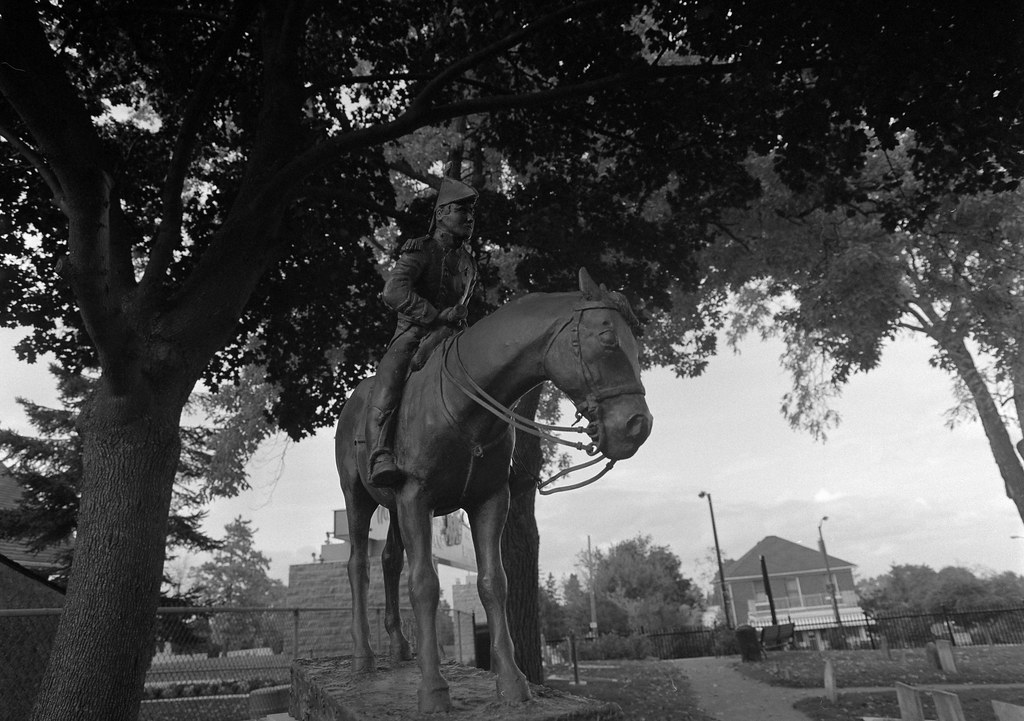
A memorial to General Drummond without who’s actions the battle would have been lost to the British.
Pentax 645 – SMC Pentax A 645 35mm 1:3.5 – Kodak Tri-X 400 – Kodak Xtol (1+1) 9:00 @ 20C
The tactical stalemate of the action left both sides wanting more. By the next morning, both sides were moving towards the hill. But it was Drummond who beat Brown to the finish line reinforcing and occupying the hill and artillery battery with force 2,200 fresh troops. Brown and Scott agreed that their men could take another action and retreated quickly back to Chippawa. Drummond rallied by this pushed forward. Brown and Scott who both had received wounds during the battle withdrew to Buffalo to be treated as the American army held at their beachhead at the now completed and fully armed Fort Erie. Drummond would make plans to lay siege to the fort.
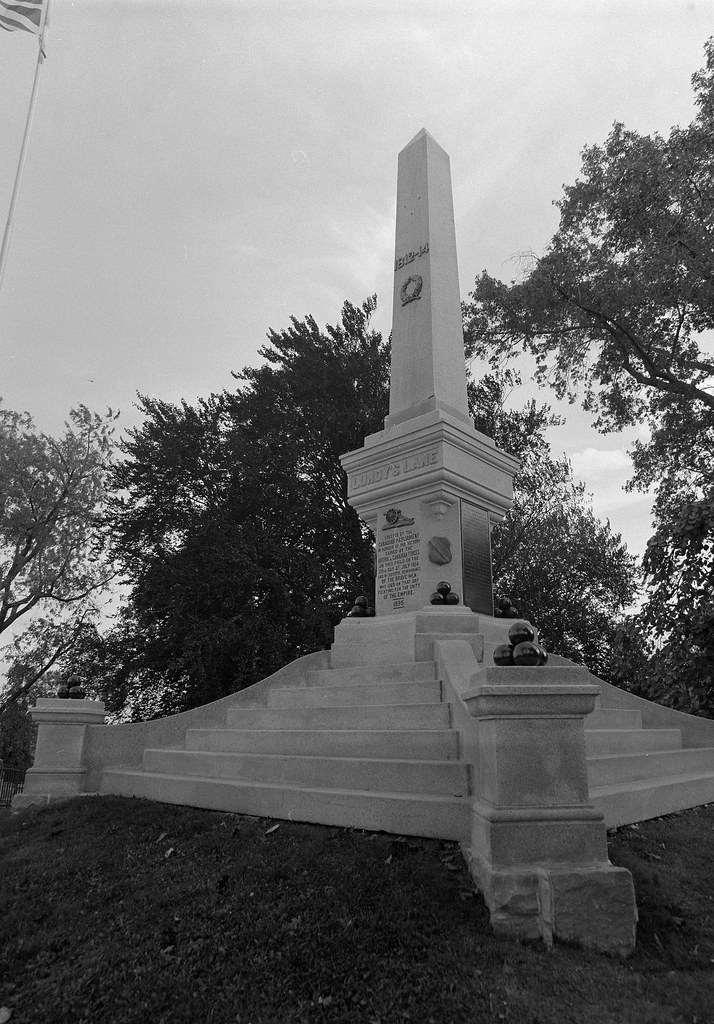
The 1895 monument and one of the more difficult memorials to photograph due to it’s location.
Pentax 645 – SMC Pentax A 645 35mm 1:3.5 – Kodak Tri-X 400 – Kodak Xtol (1+1) 9:00 @ 20C
Today you can still visit the battlefield, like in 1814 the site is a public cemetery. A monument was raised on the site in 1895 to the battle, and the site contains the graves of several notable Canadian including Laura Secord. Several other plaques and monuments outline the action there are even markers dedicated to the American soldiers who died in action. A museum across the street operated by the Lundy’s Lane Historical Society is also available for visits.
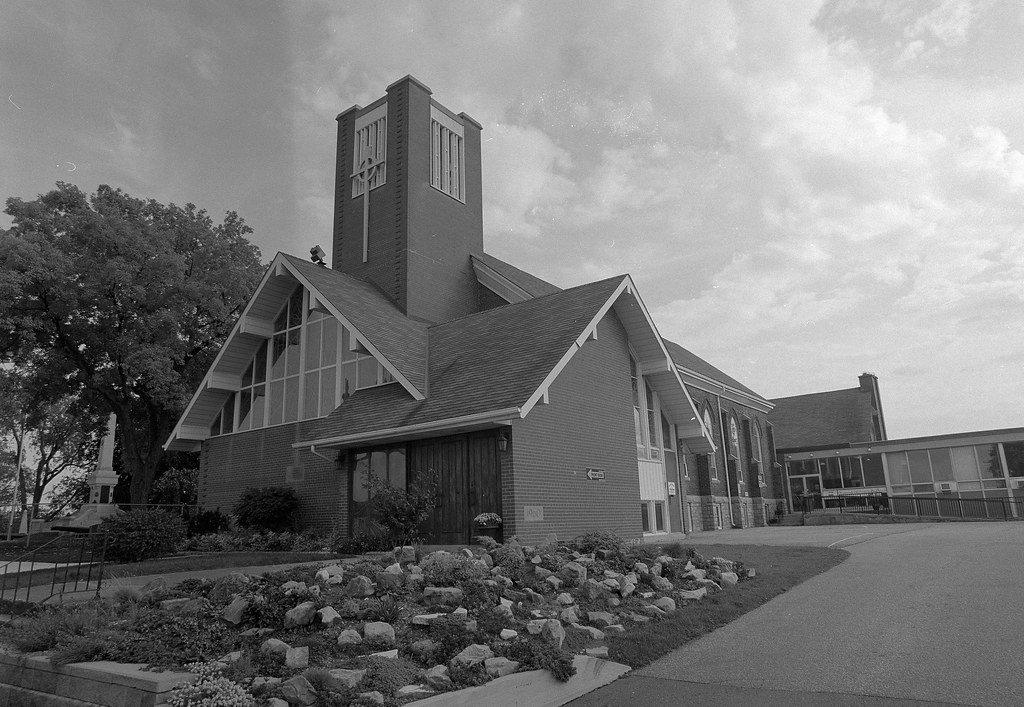
A Presbyterian church has always watched over the cemetary, today is no different.
Pentax 645 – SMC Pentax A 645 35mm 1:3.5 – Kodak Tri-X 400 – Kodak Xtol (1+1) 9:00 @ 20C
Written with Files from:
Collins, Gilbert. Guidebook to the Historic Sites of the War of 1812. Toronto: Dundurn, 2006. Print
Hickey, Donald R. Don’t Give up the Ship!: Myths of the War of 1812. Urbana: U of Illinois, 2006. Print.
Hickey, Donald R. The War of 1812: A Forgotten Conflict. Urbana: U of Illinois, 1989. Print.
Lossing, Benson John. The Pictorial Field-book of the War of 1812 Volume 2. Gretna, LA: Pelican Pub., 2003. Print.
Berton, Pierre. Flames across the Border, 1813-1814. Markham, Ont.: Penguin, 1988. Print.